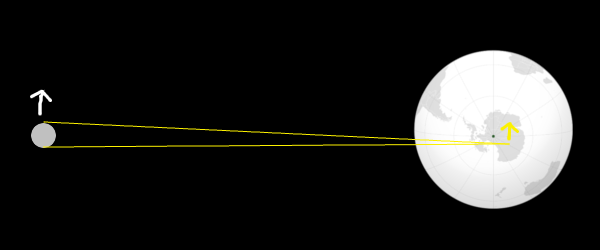Why eclipses move west to east
I observed the recent eclipse from a local park, where a bunch of people had gathered, and there was confusion about why the moon appeared on the lower side of the sun’s disk, rose over the course of the eclipse, and left off the top side, which was a west-to-east direction. (Here in North America, the sun was in the western sky for the eclipse. In Asia, the moon’s disk still moves west-to-east, but as it was in the eastern sky, that started above the sun and ended below.) This is due to a few astronomical facts: The earth’s rotation, the earth’s orbit, and the moon’s orbit are all around axes that point in roughly the same direction; the moon orbits the earth more frequently than the earth orbits the sun and the earth revolves even more frequently; and the moon’s shadow moves across the earth faster than the surface moves from the earth’s rotation. (An eclipse lasts shorter than a day, which is shorter than a month, which is shorter than a year.) Because the axes all roughly align, everything is moving in the same direction, west to east. Because we on the earth’s surface are moving west-to-east with the earth’s rotation, we see everything that revolves more slowly than the earth’s rotation as moving east-to-west in the sky. If the earth weren’t rotating, then we’d see the moon and sun move west to east in the sky, taking a month and year to complete their circuits. The disk of the moon moves through the sky over 12 times as fast as the disk of the sun, so relative to the sun we see it moving west to east.
At the park, I tried explaining this by pointing to the sky and moving my arms along west-east trajectories, but perhaps some diagrams will help. Looking down from above the north pole:
![[Earth and moon]](/img/eclipse-diagram5.png)
We see how the moon is moving west-to-east through space, but as the earth is rotating west-to-east with such a higher angular velocity, its disk moves east-to-west through our sky.
Now, when an eclipse happens, the moon’s shadow falls on the earth:
![[Eclipse in Pacific Ocean]](/img/eclipse-diagram4.png)
Because the moon only needs to pass through a tiny fraction of its orbit to sweep its shadow from one edge of the earth to the other, its shadow moves quicker than the earth’s rotation, so its west-to-east motion overtakes the earth’s surface’s, and we perceive the eclipse as starting to the west and moving east (in this case, starting in Asia and moving east over the North Pacific to North America).
At least that’s the normal case. These axes aren’t quite aligned: As the earth’s axis is tilted some 23 degrees, it’s possible for a polar eclipse to occur “north” of the north pole or “south” of the south pole:
![[Antarctic eclipse, side view]](/img/eclipse-diagram6.png)
Here the shadow is still moving “west” to “east” from the perspective an observer away in space, but our reference for east and west is the earth’s 23-degree-tilted surface, so reversed, and we’d consider such an eclipse to be moving from east to west. Looking down from above the south pole:

Here we see that the moon is still moving west to east like always, and the shadow follows the moon, but because it passes over the south pole, it goes from moving with the earth’s rotation to against it, so we observe it moving east to west on the earth’s surface.

